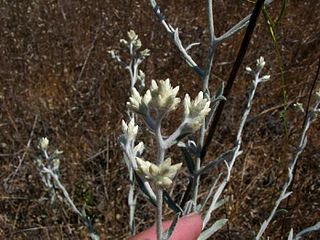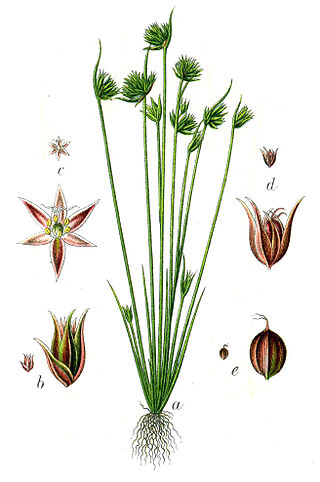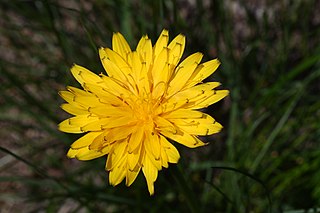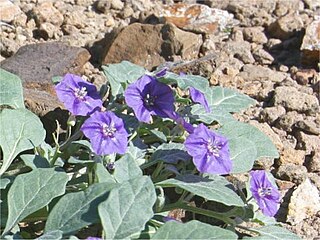
Thalictrum thalictroides, the rue-anemone, is a herbaceous perennial plant native to woodland in eastern North America. It has white or pink flowers surrounded by a whorl of leaflets, and it blooms in spring.

Dimeresia is a monotypic genus in the sunflower family containing the single species Dimeresia howellii, known by the common name doublet.

Achyronychia is a monotypic genus of flowering plant containing the single species Achyronychia cooperi, which is known by the common names onyxflower and frost-mat. This plant is native to the Mojave and Sonoran Deserts of northern Mexico and the U.S. states of California, Nevada, Utah and Arizona. In California, it is known from San Diego, Imperial, Riverside, Los Angeles, San Bernardino and Inyo Counties. In Arizona, it occurs in Yuma, Mohave, Pima, Pinal and Maricopa Counties. It has also been reported from Washington County in Utah, and from Clark County, Nevada.

Eatonella is a North American genus of plants in the family Asteraceae containing the single known species Eatonella nivea, which is called by the common name white false tickhead. This small annual is native to the western United States, particularly the Great Basin, where it grows in sandy soils. It has been found in Washington, Oregon, Idaho, Nevada, and eastern California.
Eleocharis atropurpurea is a species of spikesedge known by the common name purple spikerush. This is an aquatic plant native to much of. It also has a wide distribution in temperate regions of North and South America and Asia. It is present in Europe, where it may be an introduced species for the most part.

Epipactis gigantea is a species of orchid known as the stream orchid, giant helleborine, and chatterbox. This wildflower is native to western North America from British Columbia to central Mexico. This is one of the most abundant orchids of the Pacific coast of North America.

Pseudognaphalium canescens is a species of flowering plant in the family Asteraceae known by the common name Wright's cudweed.

Hemitomes is a monotypic genus of plants containing the single species Hemitomes congestum, which is known as gnome plant and cone plant. This rare and unusual plant is native to the west coast of North America from British Columbia to California, where it grows in dense, dark forests such as the redwood forests of the region. This is small, fleshy, stemless perennial plant forming lumps in the leaf litter. It is white, yellowish, or reddish-pink in color. Little is known about the life cycle of the plant due to its rarity, but it probably obtains its nutrients by parasitizing fungi, so it lacks the green of chlorophyll. It grows from a rhizome with fragile roots and its form is covered in sparse scales which are the rudimentary leaves. An inflorescence emerges on a thick stalk from the soil bearing solitary to densely bunched flowers. The flowers have ragged yellowish or pinkish petals and contain hairs and large rounded yellow stigmas. The fruit is a fleshy white berry.

Juncus capitatus is a species of rush known by the common names dwarf rush and leafybract dwarf rush. It is native to Europe, Asia and North Africa. It is also an introduced species in parts of North America such as California and the Gulf Coast. It grows in moist areas, such as wet sand, vernal pools, and ditches.

Agoseris glauca is a species of flowering plant in the family Asteraceae known by the common names false dandelion, pale agoseris, prairie agoseris, and short-beaked agoseris. It is native to western North America.

Allium cratericola is a species of wild onion known by the common name Cascade onion. It is endemic to California, where is an uncommon member of the flora in several of the state's mountain ranges, including the northern and southern California Coast Ranges, the western Transverse Ranges, Klamath Mountains, and the Sierra Nevada foothills. Its range covers much of the state, from Riverside County to Siskiyou County.

Artemisia spinescens is a North American species of sagebrush in the sunflower family, known by the common name budsage.

Prosartes hookeri is a North American species of flowering plants in the lily family known by the common names drops of gold and Hooker's fairy bells.

Rhododendron menziesii, also classified as Menziesia ferruginea, is a species of flowering plant in the heath family Ericaceae, known by several common names, including rusty menziesia, false huckleberry, fool's huckleberry and mock azalea.
Minuartia pusilla is a species of flowering plant in the family Caryophyllaceae known by the common names annual sandwort and dwarf stitchwort.

Nothocalais alpestris is a species of flowering plant in the family Asteraceae known by the common name alpine lake false dandelion. It is native to the Cascade Range, Sierra Nevada and other mountains from northern Washington to central California, where it grows in subalpine forests and meadows, most commonly at 1,200–2,700 m (4,000–9,000 ft) elevation.

Quincula is a monotypic genus of flowering plants in the nightshade family, Solanaceae. The sole species it contains, Quincula lobata, is commonly known as Chinese lantern, lobed groundcherry, or purple groundcherry.

Stellaria longifolia is a species of flowering plant in the family Caryophyllaceae known by the common name longleaf starwort. It is native to much of the northern half of the Northern Hemisphere, occurring throughout northern Europe and North America. It grows in many types of moist habitat, including meadows, marshes, and roadsides. It is a rhizomatous perennial herb forming clumps with sprawling, branching stems which are mostly hairless except for tiny rough hairs along the edges of the squarish stem. The linear to lance-shaped leaves are up to 3.5 centimeters long and are oppositely arranged in pairs. The inflorescence bears several flowers, each on a short pedicel. The flower has five pointed green sepals each a few millimeters long. There are five white petals, each so deeply lobed it appears to be two.

Trautvetteria is a genus of flowering plants in the buttercup family. Today it is often considered a monotypic genus, containing only one species, Trautvetteria caroliniensis, which is known by the common names Carolina bugbane, false bugbane, and tassel-rue. A second species, T. japonica, is now generally considered a variety of this species. The genus is named for the botanist Ernst Rudolf von Trautvetter.

Heliopsis helianthoides is a species of flowering plant in the family Asteraceae, known by the common names rough oxeye, smooth oxeye and false sunflower. It is native to eastern and central North America from Saskatchewan east to Newfoundland and south as far as Texas, New Mexico, and Georgia.





















